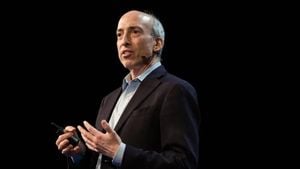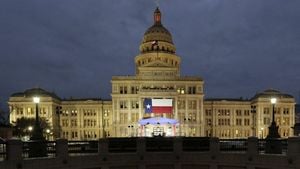On November 7, 2024, the U.S. Federal Reserve made waves by cutting its benchmark interest rate by 25 basis points, bringing it down to the range of 4.50% to 4.75%. This decision, albeit somewhat expected, injected new life—and perhaps some confusion—into markets as Fed Chairman Jerome Powell took on a cautious tone during announcements.
The rate cut followed previous actions where the Fed had trimmed rates by 50 basis points during the September meeting, alluding to hopeful signs of inflation approaching its target of 2%. The Fed’s latest meeting pointed toward easing trends within the job market and inflation, indicating progress, albeit tenuously, toward financial stability. Yet, as Powell remarked, the outlook remains uncertain, especially with external pressures looming large.
Looking forward, Fed officials have indicated expectations for continued rate cuts, potentially guiding the benchmark down to between 2.75% and 3% by 2026. This vision, of course, hinges on various macroeconomic dynamics including growth patterns and inflation rates. Of notable concern is how the ever-evolving political scene—particularly the possible return of former President Donald Trump—could shape the Fed’s future strategies.
Could Trump’s Return Influence the Fed’s Rate Decisions?
Trump’s potential re-entry to the political arena creates discussions of how his administration might impact monetary policy. Historically, Trump has been outspoken against Powell’s leadership at the Fed and even toyed with the idea of replacing him during his past term. If Trump resumes leadership, analysts speculate his pro-growth fiscal policies—which include aggressive tariffs and tax cuts—could inflate costs and inadvertently lead to higher long-term interest rates. This scenario could slow down the Fed's pace of rate reductions, impacting consumer behavior and investment strategies.
The fears are not just speculative; experts like Hitesh Jain, who oversees equity strategy at Yes Securities, contend Trump's policies could impede rate cuts predicted for 2025. His expected measures—increased import duties and ramped-up fiscal spending—could push inflation higher, inevitably leading the Fed to respond with elevated interest rates to maintain economic equilibrium.
Impact of Trump’s Fiscal Policies on Inflation and Rates
Factors such as increased tariffs on imports, stricter immigration rules, and heightened spending on national security and border control under Trump’s policies present potential inflationary pressures. Should his administration revert back, this might trigger greater government borrowing, pressuring interest income from bonds and complicantly altering the Fed's rate strategies.
Akhil Mittal, the Senior Fund Manager at Tata Asset Management, emphasizes the Federal Reserve's intent to keep its policy decisions firmly anchored on macroeconomic indicators, even as they navigate these politically charged waters. The Fed will monitor fiscal policies vigilantly to help preempt any threats to financial stability, adjusting rates based on inflationary influences and economic growth, he asserts. “The Fed is likely to maintain a careful eye on fiscal policy to avoid financial instability,” Mittal noted.
The Fed’s Focus on Growth and Inflation Data
Even with the looming influence of political maneuvering, most analysts believe the Fed remains fundamentally committed to monitoring economic data as its primary guide. Inflation rates, employment statistics, and growth figures will be the cornerstones influencing their decisions going forward. The Fed's cautious communication strategy signals its recognition of changing inflation dynamics without being too hasty to act. This is particularly evident through changes made to their language around inflation, noting it has “made progress” rather than using stronger positive terms.
Such nuances could indicate they’re prepared to adapt accordingly—perhaps even pausing future cuts if inflation maintains stability. The Fed’s approach suggests it may prefer to remain cautious and flexible, especially as the economic environment continues to send mixed signals. Investors have reacted tentatively, with futures markets hinting at possible pauses next month.
Investors and analysts are closely watching how global economic trends intersect with local decisions. Among other things, they are curious how external markets will react to U.S. changes as financial contexts shift globally. The Federal Reserve has found itself at the center of these dynamics, as upward movements on the global financial field beckon it to reconsider its stance.
Global Impact and the RBI’s Response
The ripple effects of the Fed’s policy shifts extend far beyond U.S. borders. For example, India’s Reserve Bank of India (RBI) may face pressure to adapt its rate policies based on U.S. strategies, which could impact investment and economic stability domestically. While some experts see December as possibly marking steady rates for the RBI, others speculate on the chance for rate cuts perhaps as early as 2025 depending on how inflation evolves domestically and internationally.
Despite significant international variables, the extent to which Trump’s return may impact U.S. policies—and by extension, the global financial fabric—remains uncertain. Ongoing discussions within political spheres continue to raise questions, creating an atmosphere thick with anticipation as key economic data sets merge with political maneuverings.
Current inflation reports could dramatically affect how the Fed and RBI strategize moving forward. If inflation data tends to remain stable or conducive to growth, the Fed appears poised to follow through with its rate-cutting strategy. But as history has shown, frequent reassessments and watchful eyes will undoubtedly play central roles in shaping American monetary policy.
With conflicting signals from both economic indicators and political dynamics, the Federal Reserve’s delicate dance through interest rate cuts exemplifies its dual mandate of fostering stable prices and enabling maximum employment opportunities.
While the immediate impact of this latest rate cut may initially seem limited, the broader economic consequences could pivot on the Federal Reserve's nuanced strategies, setting the stage for the U.S. economic resilience amid myriad uncertainties.



